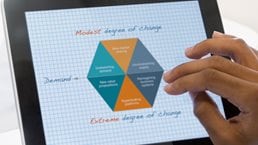In sector after sector, companies are asking how they can adapt to the digital world—how they can build more digital capabilities, create more digital offerings, and even become “digital first” organizations.
But for institutions that have served customers for decades in person and over the phone, digital too often falls short. After the debut of a new app, for example, a jump in sales may not be as big as expected, while hoped-for operational efficiencies—such as a reduction in expensive call-center and in-store customer-support requests—hardly materialize.
Executives naturally wonder why: aren’t customers demanding digital? Without question, they are. But not to the exclusion of other channels, which remain critically important.
For example, as much attention (and fear) as Amazon may generate among traditional retailers, as of early 2016 about 92 percent of retail sales in the United States—the company’s home and largest market—were still taking place in person. Furthermore, our analysis of market research confirms that many customers (including large majorities in some markets and industries) want to move freely from channel to channel in an omnichannel experience. Accordingly, the digital end-to-end offerings and internal capabilities that companies are building are important not only in themselves but also in the way they support the other channels (see Driek Desmet, Ewan Duncan, Jay Scanlan, and Marc Singer, “Six building blocks for creating a high-performing digital enterprise,” September 2015).
Retailers have increasingly recognized this reality, with some folding one-time web-only subsidiaries back into their larger businesses. But in other consumer-facing industries, such as financial services or telecommunications, digital efforts often end up becoming just another channel—in effect, a whole set of subchannels including mobile, social, and chat. Given that channel conflicts have bedeviled large companies for decades, with competition among channels sometimes more intense than with the outside world, adding even more to the list is not ideal. The result? More complexity (and cost) for the company and a less-than-optimal experience for customers.
By contrast, integrating digital into an omnichannel experience breaks down barriers for customers—and for performance, allowing companies to hone their digital skills in a way that takes advantage of their strength in traditional channels. But first, companies must break down their own internal barriers, initially by developing a more sophisticated understanding of how their customers think about all of the channel options. Mapping out the journeys customers follow among the channels reveals the most important opportunities for channels to cooperate, forming a list of changes for the company to roll out. Finally, to ensure the changes last, each major journey will need its own leader and cross-unit team—supported by revamped incentive structures to facilitate cooperation, new performance dashboards, a road map for transformation, and clear communications and governance from top executives.
Getting these steps right provides new opportunities to make customers happy—for instance, by letting them start a loan application on their phone before bed and finish it at a branch the next day after asking a few questions via the call center. Capturing moments such as these turns omnichannel into a major growth platform.
After it tightened the links between its digital and traditional channels, a large regional bank increased sales of current-account and personal-loan products by more than 25 percent across all channels (Exhibit 1). And a European telecommunications company saw a 40 percent increase in usage of its online service channel, reducing its costs by more than 20 percent while increasing customer satisfaction by more than five percentage points.

The obstacles to omnichannel
Companies are starting to understand the omnichannel imperative. But getting there is proving unexpectedly difficult.
A bias toward bigness. Part of the reason is a misplaced belief that omnichannel’s massive implications require equally massive actions, such as an entirely new IT platform or organization structure to bring all channels together. Too often that “silver bullet” mentality leads only to a massive misallocation of resources. Instead, the companies that are most successful in making the digital and omnichannel transition concentrate on a long, prioritized list of pragmatic initiatives that, as they are implemented, unleash the value trapped in the intersections among poorly coordinated channels. Collectively these initiatives counter two larger problems:
Disregarding diversity. In our experience, most companies tend to build their digital and omnichannel experience believing that most customers have basically the same needs and follow basically the same journeys. In reality, customers are far more diverse, not only in their needs but also in how they want to meet those needs. For example, a recent survey of North American mobile customers showed that while approximately 35 percent would turn to digital channels first in dealing with an administrative issue, such as a change of billing information, only 24 percent would use digital channels for solving a technical problem. And, of course, even with administrative issues, more than half of customers preferred either in-person or phone resolution, illustrating how many different pathways are possible within the same basic journey. Accommodating these different behaviors will require organizations to understand their customers better while becoming more flexible in allowing for more options to reach the same end point.
Would you like to learn more about our Operations Practice?
Curbing cooperation. But the need for greater flexibility usually bumps into a hardened reality. Despite decades of discussion about conflicting channels, many companies still operate each channel as a separate organization, expecting it to optimize its own performance and service model while showing its own results. Incentives ostensibly designed to encourage performance unintentionally reinforce the channels’ isolation—such as revenue-generation targets that push each channel to increase its own sales volume regardless of any impact on sister channels. Competition becomes even more brutal internally than with the outside world.
The better breakthrough: Start small, from the customer
A better outcome is possible, but only by taking a more disciplined approach to understand how different customers think and behave at each step of their individual journeys. By revealing customers’ most important pain points, the resulting analysis helps the organization see which changes to make first, gradually making an entire process simpler and more effective for customers from beginning to end.
1. Discovering ‘personas’
The first step, describing how customers act, sounds daunting. But it’s actually less so because customers’ behavior usually coalesces around a few major variables. These become the basis for creating “personas” describing major segments of the customer population in a richer way than traditional demographic-based segmentation allows.
For example, in wireless services, the major variables could include customers’ comfort levels with mobile technology, the role mobile technology plays in their lives, their financial sophistication, their occupation, and the way they shop—how much comparison shopping they do and what information sources they use. A “work and play” persona would be a professional who relies heavily on her mobile phone both for her job—communicating with clients, managing her calendar, and making travel arrangements—and for personal activities, such as paying bills, shopping for groceries, and making investments. Her busy schedule leaves little time for shopping, so for major purchases she relies on quick Internet searches to understand features and prices. Her ideal is to buy online and then pick items up in the store on her lunch break, rather than wait for delivery.
By contrast, a “social enthusiast” is a bit younger, less likely to have a job requiring a mobile device, and instead uses his phone mainly to keep up with friends and play multiplayer games. He may be more likely to be on a tight budget, so he researches purchases extensively, looks to social networks for a consensus on the best option, tests it out in person, and sends victorious tweets when he “scores a great deal.”
The same basic patterns repeat across industries—in small-business banking, for example, technology and financial sophistication both matter, as does a business’s size and its financial goals. Describing four to six major personas is usually enough to cover about 80 percent of the customer base.
2. Charting a journey’s map
The next step is to understand the personas’ different needs and follow the steps, both offline and online, that the each persona takes along a given journey. The crucial requirement is to identify the important (and often hidden) pain points that the persona encounters and the resulting areas of opportunity for redesign.
Some of the opportunities may be visible just by mapping all of the current journeys customers can follow across all channels and displaying them together (Exhibit 2). For the regional bank, two points showed particular problems. In the online channel, about 80 percent of customers dropped out rather than fill in a registration form. And in call centers, more than 98 percent of customers did not ask for an offer. A similar map for the European telco found that regardless of which channel customers started in, if they ended up on the online shop, they abandoned their purchases fully 99 percent of the time. Furthermore, across all channels, 30 percent of orders were never activated.

The reasons for these outcomes tend to differ by persona. The work-and-play user’s main challenges center on time: there’s not enough of it. She may grow impatient at sorting through too many options and give up when a form asks for information that she knows the company already has (“They know where I live—my statement arrives every month like clockwork. This is wasting my time.”) Meanwhile, the social-enthusiast user wants to get the best service and product he can get for the lowest price, without committing to a long contract in case a better option comes along later. He may keep getting timed out of his purchase while looking at his social feeds to figure out if the option he’s considering is really the right one.
3. Designing a portfolio of omnichannel initiatives for each improvement area
These findings lead directly to a multipronged improvement strategy comprising several dozen initiatives, ranging from better data links to prepopulate online order forms to revamped offers and new performance-measurement practices. The goal is for each of the initiatives to be pragmatic and achievable, while together they deliver profound and lasting change.
The most urgent changes typically concern the digital channel, where customers often face a vast range of choices with complex pricing provisions and business rules that make it almost impossible to find the right combination (see sidebar, “Becoming more agile—in IT and in processes”). Instead, a new structure would change the experience from the moment a user arrives on the page. Rather than show the same page for everyone, the new page would vary depending on the user’s persona, which typically could be assigned based on a combination of existing customer data and the user’s prior browsing behavior on the site.

Strategy in a digital age
Our series on developing corporate and business-unit strategies in a digitally disrupted world.
The customer therefore has a much more customized experience. A work-and-play user would be taken directly to two or three simple product options based on phone features and service limits. After choosing one of the options, the user would see a second page of add-ons, such as purchase-protection plans and international coverage. Social enthusiasts, by contrast, would get a more detailed interface that allows them to make separate decisions for the phone and for the service levels, so that they can understand the trade-offs and feel like they’re getting the best bang for their buck. The page they see also would provide user-generated product reviews from other clients, social-network links, a chat feature staffed by sales representatives, and a tool to set up in-store appointments.
4. Enabling continuous refinement and improvement
The effort these changes require is too great for an organization to watch the returns fade away and then repeat the exercise a year or two later. Revisiting its internal governance, performance, and capabilities becomes critical to support essential cultural changes and ensure that the organization’s performance continues to improve as the market evolves.
Although difficult, restructuring the traditional governance approach—in which channels operated almost as separate businesses—is the best defense against the most immediate threat to the omnichannel model’s long-term health: the reemergence of silos. During the transformation process, the organization forms cross-unit teams with representation from each channel and from supporting functions such as IT, marketing, and compliance. Each team operates as a work cell, with accountability for the design and implementation of a set of initiatives. As the changes take hold, the cells become the basis for a new organization structure that continually reassesses how the omnichannel model is functioning, identifying improvement opportunities and translating them into new rounds of initiatives for implementation.
Accountability will also depend in part on new performance targets that encourage collaboration instead of competition among channels. That means, for example, deciding how to allocate credit for shared sales that start in one channel and end in another, and agreeing on performance indicators that provide concrete evidence the collaboration is occurring. Shared key performance indicators for digital, sales, and IT, such as the speed of change implementation or the level of digital adoption, help show whether the different functions are actually working together or whether they are finding reasons to block new initiatives.
Throughout the organization, people will need new capabilities at every level. Frontline sales and service personnel, for example, will need new and deeper skills in recognizing customer needs, understanding where the customers are in their journeys, and finding the most effective ways to help them depending on which persona they best match and which channels would best serve them. The greater complexity of frontline positions will require more coaching and support from managers, who will need their schedules freed up so that they can spend more time with their teams. And senior executives will need to play a more prominent part in role modeling behavior changes, such as in encouraging problem solving by people closer to the customer rather than imposing solutions from above.
What would it mean for your organization if you could promise your customers that they’ll get the service they need, however they need it? How much more effective would your people be if they didn’t have to worry about losing a customer to another channel? Becoming truly omnichannel is demanding for an organization. But the answers it provides to questions such as these make it worth the investment for organizations willing to make the commitment.


